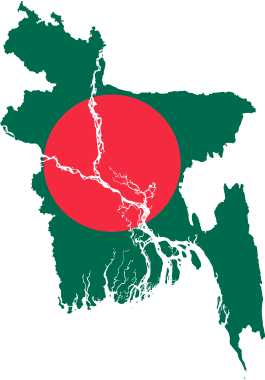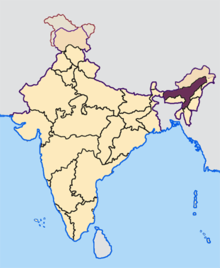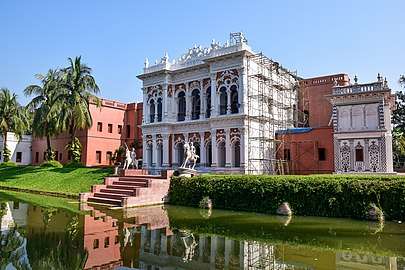Baro-Bhuyan
The Baro-Bhuyans (Assamese: বাৰ ভূঞা), also spelled variously as Baro-Bhuinas and Baro-Bhuiyans, were warrior chiefs and landlords (zamindars) in the regions of late middle age and early modern Assam and Bengal of the Indian subcontinent, who maintained a loosely independent confederacy. These landlords did not belong to any particular ethnicity, religion or caste.[1]
| Outline of South Asian history | ||||||||||||||||||||||||||||||||||||||||||||
|---|---|---|---|---|---|---|---|---|---|---|---|---|---|---|---|---|---|---|---|---|---|---|---|---|---|---|---|---|---|---|---|---|---|---|---|---|---|---|---|---|---|---|---|---|
_without_national_boundaries.svg.png) | ||||||||||||||||||||||||||||||||||||||||||||
|
Palaeolithic (2,500,000–250,000 BC) |
||||||||||||||||||||||||||||||||||||||||||||
|
Neolithic (10,800–3300 BC)
|
||||||||||||||||||||||||||||||||||||||||||||
|
Chalcolithic (3500–1500 BC)
|
||||||||||||||||||||||||||||||||||||||||||||
|
Bronze Age (3300–1300 BC)
|
||||||||||||||||||||||||||||||||||||||||||||
|
Iron Age (1500–200 BC)
|
||||||||||||||||||||||||||||||||||||||||||||
|
Middle Kingdoms (230 BC – AD 1206) |
||||||||||||||||||||||||||||||||||||||||||||
|
Late medieval period (1206–1526)
|
||||||||||||||||||||||||||||||||||||||||||||
|
Early modern period (1526–1858)
|
||||||||||||||||||||||||||||||||||||||||||||
|
Colonial states (1510–1961)
|
||||||||||||||||||||||||||||||||||||||||||||
|
Periods of Sri Lanka
|
||||||||||||||||||||||||||||||||||||||||||||
|
Specialised histories |
||||||||||||||||||||||||||||||||||||||||||||
Part of a series on the |
|---|
| History of Bangladesh |
 |
|
|
Ancient
|
|
Classical
|
|
Medieval
|
|
Modern
|
|
Contemporary
|
|
Related articles |
|
|
The system of Baro-Bhuyan confederacy is a relic of the erstwhile Kamarupa kingdom, that covered all of Assam, North Bengal and large portions of Bangladesh.
In times of aggression by external powers, they generally cooperated in defending and expelling the aggressor. In times of peace, they maintained their respective sovereignty. In the presence of a strong king, they offered their allegiance.[2] In general, they were in control of a group of villages, called cakala, and the more powerful among them called themselves raja.[3]
Baro denotes the number twelve, but in general there were more than twelve chiefs or landlords, and the word baro meant many.[4] Thus, Bhuyan-raj denoted individual Bhuyanship, whereas Baro-Bhuyan denoted temporary confederacies that they formed.[5] In Bengal they carved the land of Bhati into twelve administrative units or Dwadas Bangla.[6] The "parcelization" of power, which was an effect of settling North Indian adventurers, became prominent during the 9th century reign of Balavarman III of the Mlechchha dynasty.[7] Whereas the central Kamarupa kingdom fragmented, the system of small chieftains remained. In Bengal as in Assam, the Baro-Bhuyans are found in regions within the traditional boundaries of the Kamarupa kingdom.
In Assam, the Baro-Bhuyans occupied the region west of the Kachari kingdom in the south bank of the Brahmaputra river, and west of the Chutiya kingdom in the north bank. These included areas of Nagaon, Darrang and Sonitpur districts. They were instrumental in defending against aggressors from Bengal, especially in defeating the remnant of Alauddin Husain Shah's administration after 1498. They also resisted the emergence of the Koch dynasty but failed. Subsequently, they were squeezed between the Kachari kingdom and the Kamata kingdom in the south bank and were slowly overpowered by the expanding Ahom kingdom in the north. In Bengal, the Kingdom of Chandradvipa or Barisal was ruled by the royal Basu family, the last of which being Raja Rabindra Narayan Bose, who later fled to Kolkata during the partition of Bengal, as their position had already been reduced to that of a zamindar. The royal family thus, still lives in Kolkata.
Baro-Bhuyans of Assam
The Baro-Bhuyans were the rulers/landlords that rose into prominence in Assam after the fall of Pala dynasty. The Bhuyans didn't have any ethnic basis and originated from different groups, both indigenous and migrants. For instance, the founder of the Koch kingdom Haria Mandal was considered a Bhuyan and headed twelve Mech families. Baro-Bhuyans of Assam can be divided into two major groups: the older group i.e. Adi-Bhuyans and the later group. The Vaishnavite saint Sankardev belonged to the later.
The Adi Bhuyan group
The origin of this group is shrouded in mystery. This original group is often referred to as the Adi Bhuyan, or the progenitor Bhuyans. The Adi-charita written in the late 17th century is the only manuscript which mentions about the Adi-Bhuyan group.[8] However, Maheswar Neog has called the account as spurious or fabricated. [9] The text states that this group originated from Samudra, who was a minister of the Kamata court under Arimatta. It claims that the Bhuyans belonged to the solar race. Pratapura was king of Ratnapura in the Ratnapitha (western Assam). He was succeeded by his son, Mayamatta, who divided his kingdom between his two sons, Arimatta and Nagamatta. The eastern portion was assigned to Arimatta, whose minister, Samudra, built him a new capital, while Nagamatta ruled the country from the old town of Ratnapura (present-day Baksa district). Over time, Arimatta annexed the entire region of Kamata kingdom and became the king of Kamatapur. The penitent Arimatta placed Samudra in charge of the eastern regions of the Kamata kingdom and Samudra's son, Manohar at Darrang. Samudra died soon after this, and Manohara also followed his path to the grave, leaving behind him only a daughter, Laksmi. She had two sons, Santanu and Sumanta.[10] Santanu and Sumanta, had twelve sons each and they formed the original Bor Baro-Bhuyan (namely Laskar, Kavyasi, Padma, Raya, Salal, Suka or Hoka, Tetan, Dhvaja or Dhoya, Uzir, Saral, Ramai and Tamai) and Saru Baro-Bhuyan (namely Kanvajavara or Kanaujavara, Raghu, Mukunda, Kadamba, Suratha, Sundara, Susama, Gaura or Gaurabaaj, Ratna, Maharath, Lep and Kep or Kesh). The Saru Baro-Bhuyans emigrated to Rampura (present-day Nagaon district) soon after while the Bor Baro-bhuyans established themselves in a place known as Lakhimpura/Lakshmipura (present-day Darrang district) which was until then known as Ranga-gaon.[11] As per the text, the Bhuyans fought with and withstood the might of the Chutiya as well as the Kachari kingdoms. The texts also states that when the Bor Baro-Bhuyans attacked the Ahom kingdom south of the Brahmaputra, all the twelve of them were taken prisoners in war. When, however, the Ahom king tried by various means to break their unity and fully subjugate them, he failed; and, therefore, he sent them as sacrifices to the goddess Shyama Kali of Sadiya. The goddess, the story goes, interceded; and they were released on the taking of the required oath of fealty. On behalf of the Ahom king, they fought with, and killed, the Kachari king and Dhirnarayana, the Chutiya king. But, this cannot be true as the temple in Sadiya came under the Ahoms only after the defeat of Chutias in 1524 AD. The wars may be the Chutia rebellions which took place in 1527 and 1529 A.D. According to the text, the Ahom Raja was so much pleased with these chiefs that he mapped out twelve small principalities like Kalabari, Gohpur, Kalangpur and Narayanpur, and placed the twelve Bor Bara-Bhuyans as tributary feudal lords. Two of their descendants, Jaya Bhuyan of Laskar's family and Mahi Bhuya of Uzir's family, became powerful and the Ahom king, Jayadhwaj Sinha, had to conclude a treaty with them. The text further states that the Saru Baro-Bhuyans migrated to the west of Rampura as a quarrel arose between the Bar and Saru groups over the Kalpataru-sastra, which passed into the latter's hands. According to the Buranjis, after the defeat of the Chutiya kingdom, the Ahom king Suhungmung suppressed all the Adi-bhuyans and transferred most of them to the northern bank of Upper Assam.[12][13][14][15] Towards the end of Suhungmung's reign, the remaining Bhuyans of Rata-Temani (Madanagiri, Dharmai, Ramacandragiri, Dandar-dalai, Tamuli-dalai, Bar-comdar, Dalid-khan and others) evacuated their own headquarters, and gathered near the river Kalang and prepared to fight with the Ahoms. On coming to the throne in 1539, Suklenmung suppressed their rebellion. After that the Bhuyans surrendered, paid homage to the Ahom monarch on the Kapili and were appointed as petty officers.[16] Thus, by the mid 16th century, all the Adi Bhuyans power was crushed, and they remained satisfied with what service they could render to the Ahom state as Baruwas or Phukans, Tamulis or Pachanis. During the first expedition of Chilarai against the Ahom kingdom, they aligned with the Ahoms (which Chilarai lost), but during the second expedition they aligned with the Koches (which Chilarai won). Chilarai appointed Uzir Bamun, Tapashi Laskar and Malamulya Laskar as Rajkhowas in Uttarkula after he annexed the territories up to Subansiri river in 1563 AD. [17] This group was finally subjugated by Prataap Singha in 1623, who relocated them to the south bank of the Brahmaputra.[18] The Saru Bhuyans, who had moved west after the conflict with the Bor Baro-Bhuyans trace the genealogy of Candivara to Kanvajara, the eldest son of Sumanta, but this is not given credence.
The Later group
The later Baro-Bhuyans had ensconced themselves between the Kachari kingdom in the east and the Kamata kingdom in the west on the south bank of the Brahmaputra river. According to Neog, the leader (shiromani) of the group, Chandivara, was originally a ruler of Kannauj, who had to flee due to Firuz Shah Tughlaq's 1353 campaign against Shamsuddin Ilyas Shah and reached Gauda, the domain of Dharmanarayana.[19] As a result of a treaty between Dharmanarayana and Durlabhnarayana of Kamata kingdom, a group of seven Kayastha and seven Brahmin families led by Candivara was transferred to Langamaguri, a few miles north of present-day Guwahati.[20] Candivara and his group did not stay in Lengamaguri for long as it was frequently inundated by the Brahmaputra and because depredations by the Bhutiyas, and moved soon to Bordowa in present-day Nagaon district with the support of Durlabhnarayana.[20] Among the descendants of Candivara was Srimanta Sankardeva.
A second group of five Bhuyans joined the Candivara group later.[20] In due course, members of these Bhuyans became powerful. Alauddin Husain Shah, who ended the Khen dynasty by displacing Nilambar in 1498, extended his rule up to the Barnadi river by defeating Harup Narayan who was a descendant of Gandharva-raya, a Bhuyan from the second group established by Durlabhnarayana at Bausi (Chota raja of Bausi), among others.[21] The Baro-Bhuyans retaliated and were instrumental in ending the rule of Alauddin Husain Shah via his son Danial. But very soon, the rise of Viswa Singha of the Koch dynasty in Kamata destroyed their hold in Kamrup[22] and squeezed those in the Nagaon region against the Kacharis to their east. They had to relocate to the north bank of the Brahmaputra in the first quarter of the 16th century, to a region west of the Bor Baro-Bhuyan group. The increasing Koch and Ahom conflicts further ate away at their independence and sovereignty.
Baro-Bhuiyans of Bengal
At the end of the Karrani Dynasty (1564-1575), the nobles of Bengal became fiercely independent. Sulaiman Khan Karrani carved out an independent principality in the Bhati region comprising a part of greater Dhaka district and parts of Mymensingh district. During that period Taj Khan Karrani and another Afghan chieftain who helped Isa Khan to obtain an estate in Sonargaon and Mymensingh in 1564. By winning the grace of the Afghan, chieftain, Isa Khan gradually increased his strength and status and by 1571 Mughal Court designated him as the ruler of Bhati.[23]
Bhati region
Mughal histories, mainly the Akbarnama, the Ain-i-Akbari and the Baharistan-i-Ghaibi refers to the low-lying regions of Bengal as Bhati.
This region includes the Bhagirathi to the Meghna River is Bhati, while others include Hijli, Jessore, Chandradwip and Barisal Division in Bhati. Keeping in view the theatre of warfare between the Bara-Bhuiyans and the Mughals, the Baharistan-i-Ghaibi mentions the limits of the area bounded by the Ichamati River in the west, the Ganges in the south, the Tripura to the east; Alapsingh pargana (in present Mymensingh District) and Baniachang (in greater Sylhet) in the north. The Bara-Bhuiyans rose to power in this region and put up resistance to the Mughals, until Islam Khan Chisti made them submit in the reign of Jahangir.[24]
Isa Khan
Isa Khan was the leader of the Baro Bhuiyans (twelve landlords) and a zamindar of the Bhati region in medieval Bengal. Throughout his reign he put resistance against Mughal invasion. It was only after his death, when the region went totally under Mughals.[24]
The Jesuit mission who sent to Bengal managed to identify that 3 of the chieftains were Hindus, they were Bakla of Bakarganj, Sripur of southeastern Dhaka (another source record the chief was Kedar Rai of Vikrampur),[25] and Chandechan of Jessore while the rest were Muslims during Isa Khan's rule which in following decades N.K Bhattasali managed to identify some of them, which consisting:
- Khwaja Usman of Bokainagar and later Uhar
- Ma'sum Khan Kabuli of Chatmogar in Pabna
- Madhu Ray of Khalsi
- Bayazid of Sylhet[26]
- Raja Ray of Shahzadpur in eastern Pabna
- the Ghazi family in Bhawal, north of Dhaka, consisted of Fazl Ghazi with his son and inheritor, Bahadhur Ghazi (who controlled a large river fleet which was important in Isa Khan's resistance against Mughal forces) along with Anwar Ghazi[27] and Sona Ghazi.
- Pahlawan of Matang in southwestern Sylhet
- Nabud/Madan of Chandrapratap
- Pratapaditya of Jessore[28]
- Ram Chandra of Bakhla[29]
- Bahadur Khan of Hijli[30]
Notes
- (Nath 1989, p. 21)
- (Neog 1980, p. 49)
- (Neog 1980, p. 48)
- (Neog 1980:49f)
- (Guha 1983, p. 10)
- Akbarnama, Volume III, Page 647
- (Lahiri 1984, p. 62)
- Neog, Maheswar, Early History of the Vaishnavite Faith and Movement in Assam, p. 29, It is supposed to have been written in 1586 saka (1664 AD).
- Maheswar Neog states that the Adi-cwita, ascribed to Madhavadeva, has created much ill feeling among the Vaisnavas of Assam, and has been denounced by the more considerate section of sattra pontiffs and literary men alike.
- Neog, Maheswar, Early History of the Vaishnavite Faith and Movement in Assam, p. 52
- As per Asamar Buranji, Rang-gram(Rangagaon) was renamed as Lakshmipur after their mother Lakshmi
- According to Assam Buranji by Harakanta Barua,p. 64, king Suhungmnung is said to have subdued the Bara Bhuyans in the year 1527 A.D. and appointed them to very petty offices as Tamulis and Pacanis.
- As per the Assam Buranji(SM) p.29, after the defeat of Chutiyas, Adi Bhuyans put on a challenging attitude and were eventually suppressed. Two Bhuyans of the Bor Baro-bhuyan stock(Rowta), Utai and Tamai, scoffed at Ahom power saying that the Ahoms were puffed up with the pride of their victory over the Chutiyas, but that all the same the country belonged to the Bhuyans. This was reported to king Suhungmung, who sent three of his minor chiefs to put down the Bhuyans. They camped on the Kadha (in Lakhimpur) when Vasudeva Tapasi Laskar, the Bhuya of Karekuchi, sent one Malabaiya Laskar to offer submission along with five horses and silver. The Bhuyans, named Laloya, Utavara, Kahika (Kausika), Comdar, Uzir, Capa, Sonavara, Bhedai and others with their relatives, were appointed as khataniyars (petty servants of state); and Utai and Tamai were put to the executioner’s sword.
- According to Purani Assam Buranji, p.27. the twelve Bara Bhuyas of Rowta-Temani (mid-Assam, on either banks of the Brahmaputra) namely Utai, Tamai, Rai, Sakai, Kausika, Uzir, Laskar, Comdar, Sanatana, Keho, Rambhat and Bhakat with four sub-Bhuyans each, were transported and settled in various places of Uttara-kula (Biswanath, Lakhimpur districts). The Lacam Kalita Bhuyan family was placed at Bahbari(Lakhimpur), while one of them was settled on the river Sonari(Dhakuakhana), and another on the hills.
- As per Satsari Buranji, p.16, Suhungmung suppressed the Baro-Bhuyans in Rowta. The people of the region were placed under the leadership of the Baro-Bhuyans and re-settled at different places of the kingdom.
- Assam Buranji(SM) p.50-52; Ahom Buranji, p. 57 ; Deodhai Assam Buranji, p. 56
- History of the Koch Kingdom, c. 1515-1615,p.58.
- (Neog 1980, p. 58)
- (Neog 1980, p. 41)
- (Neog 1980, p. 51)
- (Neog 1980, pp. 53–54)
- (Neog 1980, pp. 54–55)
- "A tale of Baro-Bhuiyans". The Independent. Dhaka. 5 December 2014. Retrieved 1 February 2015.
- Karim, Abdul (2012). "Bara Bhuiyans, The". In Islam, Sirajul; Jamal, Ahmed A. (eds.). Banglapedia: National Encyclopedia of Bangladesh (Second ed.). Asiatic Society of Bangladesh.
- Ahmed, Salahuddin (2004). Bangladesh: Past and Present. APH Publishing. pp. 64–. ISBN 978-81-7648-469-5.
- Saha, Sanghamitra (1998). A handbook of West Bengal. International School of Dravidian Linguistics. p. 110.
- Chatterjee, Partha (2002). A Princely Impostor?: The Strange and Universal History of the Kumar of Bhawal. Princeton University Press. p. 17. ISBN 978-0-691-09031-3.
- Nagendra Nath Ray (1929). Pratapaditya. B. Bhattacharyya at the Sree Bhagabat Press.
- Eaton, Richard Maxwell (1996). The Rise of Islam and the Bengal Frontier, 1204–1760. University of California Press. pp. 148–. ISBN 978-0-520-20507-9.
- Khan, Muazzam Hussain. "Bahadur Khan". Banglapedia: National Encyclopedia of Bangladesh. Asiatic Society of Bangladesh.
References
- Guha, Amalendu (December 1983). "The Ahom Political System: An Enquiry into the State Formation Process in Medieval Assam (1228–1714)". Social Scientist. 11 (12): 3–34. doi:10.2307/3516963. JSTOR 3516963.CS1 maint: ref=harv (link)
- Lahiri, Nayanjot (June 1984). "The Pre-Ahom Roots of Medieval Assam". Social Scientist. 12 (6): 60–69. doi:10.2307/3517004. JSTOR 3517004.CS1 maint: ref=harv (link)
- Nath, D (1989), History of the Koch Kingdom: 1515–1615, Delhi: Mittal PublicationsCS1 maint: ref=harv (link)
- Neog, M (1992), "Origin of the Baro-Bhuyans", in Barpujari, H. K. (ed.), The Comprehensive History of Assam, 2, Guwahati: Assam Publication Board, pp. 62–66CS1 maint: ref=harv (link)
- Neog, M (1980), Early History of the Vaisnava Faith and Movement in Assam, Delhi: Motilal BanarasidassCS1 maint: ref=harv (link)


